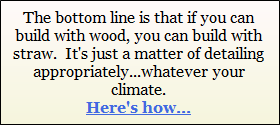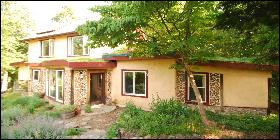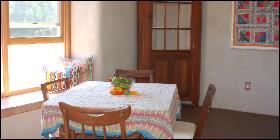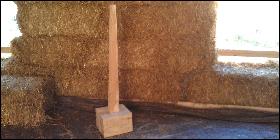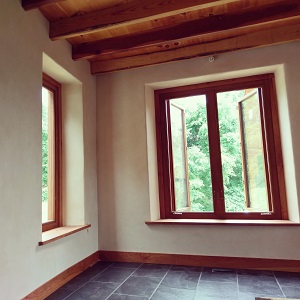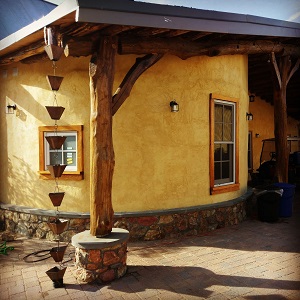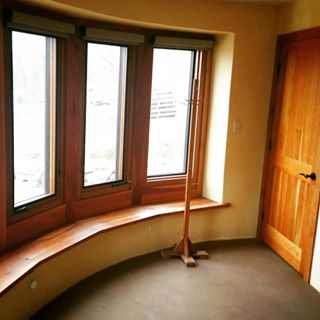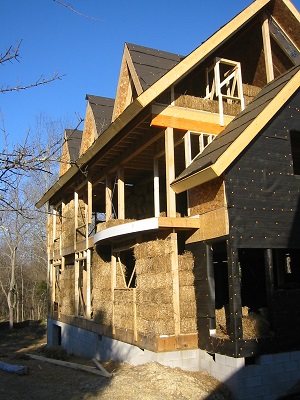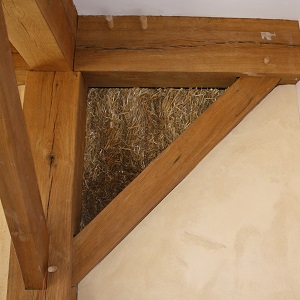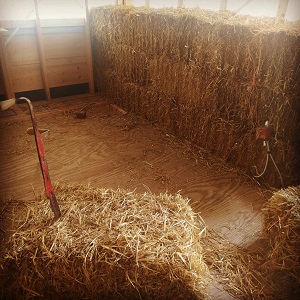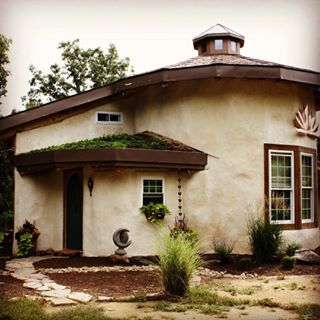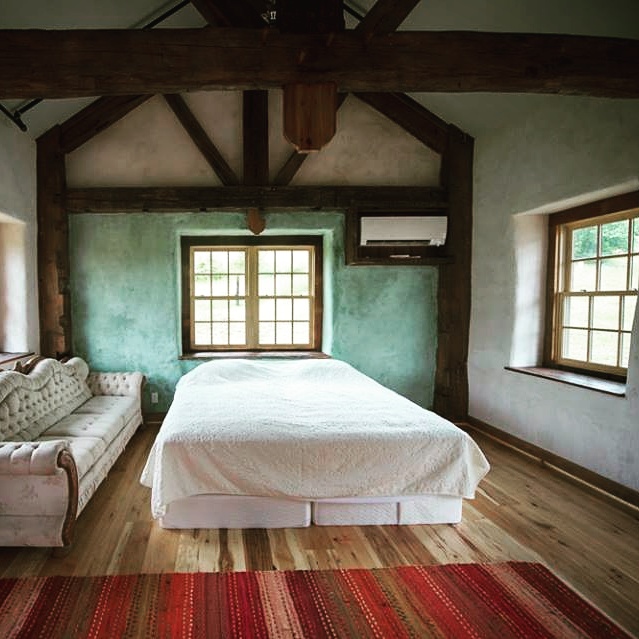AT A GLANCE
R-2.7 per inch of thickness
meets all fire safety codes
meets hurricane wind-load codes
can be used in wet/humid climates
inexpensive material
modest labor to install
BEST USE
use as insulation to reduce heating or cooling energy
(wherever you plan to use heating or air conditioning systems)
LINK TO GLOSSARY
Read the glossary description here.
STRAWBALE WALLS
Strawbale walls use large bricks, made from straw fibers, stacked to form a super-insulating wall. Both sides are typically finished with breathable plasters, made from clay or lime. Walls are thick (averaging 16" to 26" depending on bale size & orientation).
Techniques are quick to learn and use simple tools. However, attention to details must be followed to ensure walls stay dry (and thus are built durably).
Here are my favorite books about strawbale construction (click the cover to purchase)
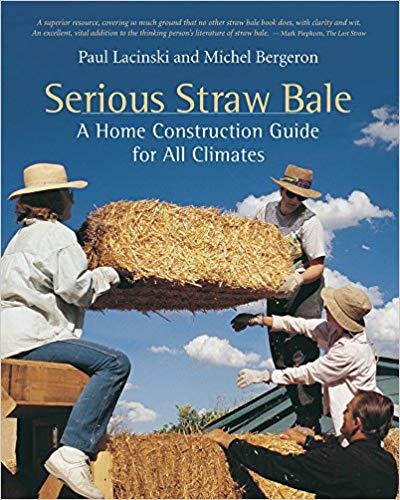
If you are looking for a single book on strawbale construction, this is the most comprehensive choice...and it addresses wet climates
Buy this book
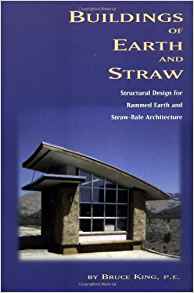
This book is written by an engineer FOR engineers. I give this book to my structural engineers so they understand how to detail natural buildings.
Buy this book
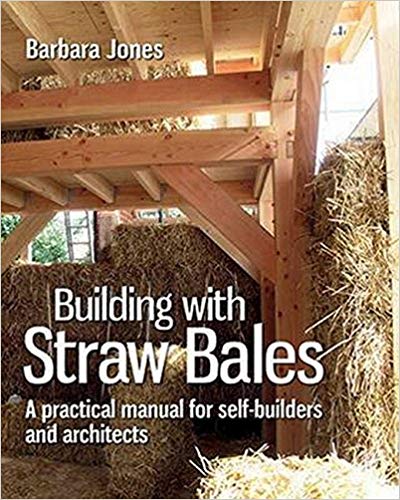
This book combines technical info with clear process photos and practical details. Useful for DIY-ers & designers alike.
Buy this book
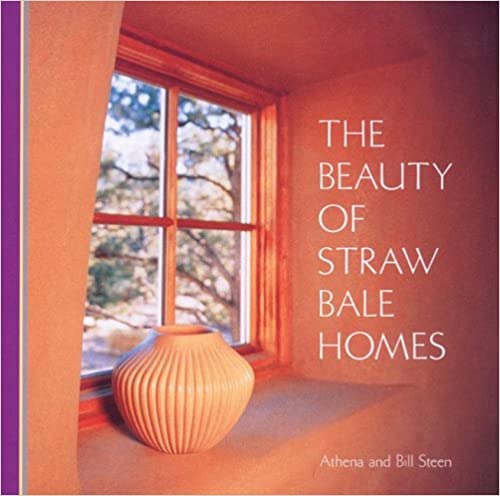
A short book with lots of photos that shows the diversity and beauty achievable with strawbales and natural finishes
Buy this book
If you are looking for one book on strawbale construction, this is the most comprehensive choice, especially for wet climates.
This book is written by an engineer FOR engineers. I give this book to my structural engineers so they understand how to detail natural buildings.
This book combines technical info with clear process photos and practical details. Useful for DIY-ers & designers alike.
A short book with lots of photos that shows the diversity and beauty achievable with strawbales and natural finishes.
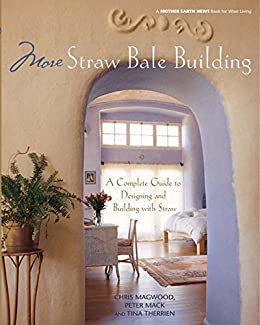
A great practical guide to strawbale construction, from design basics to construction details
Buy this book
A great practical guide to strawbale construction, from design & permitting basics to details for construction and finishing.

Straw has been used as a construction material for as long as there has
been agriculture. Early structures implement straw-clay combinations. The
straw provides tensile strength and insulation, and the clay glues the loose fibers
together. Baled straw was first used in construction in the late 1800's by settlers in
Nebraska. The innovation was a product of newly invented baling machines, as well
as limited availability of conventional building materials in the prairie Midwest.
Strawbales were used to construct many types of buildings, including schools, barns,
houses, corer stores, and more. Some 75+ year-old buildings are still inhabited
today. And historic strawbale structures can be found in a variety of
climates: from hot to cold, and from dry to humid.
Straw is the stalk of any grain plant: oat, wheat, rice, barley, etc. Straw is high
in cellulose, similar to wood, and is therefore not highly nutritious to farm animals.
(This is different from hay, which is dry grass, and is grown as food source.) After
grain harvest, a small percentage (up to 15%) of the stalks can be tilled back in to the
soil to re-supply nitrogen. The remaining stalks, however, are essentially a waste
product. Farmers used to burn much of this waste, releasing fine particles and CO2
into the atmosphere...contributing to pollution and climate change. Burning is now
widely banned, leaving farmers to search for other uses for straw. When
California banned straw burning, grain farmers were instrumental in
helping to pass a building code for strawbale construction.
Strawbale wall construction takes 2 forms: loadbearing (or Nebraska
style) and infill (non-loadbearing walls). Loadbearing construction, as its name
implies, uses strawbales as large building bricks that support all of the building loads.
Infill construction uses an independent structural system with strawbales filling in
between. This overview addresses strawbale infill techniques.
Best Use
Use strawbales to minimize energy for heating or cooling.
Strawbale walls provide very high insulation (R-36 minimum). Insulation
slows the transfer of heat through your walls. In other words, heat stays inside in
winter and outside in summer. Therefore, strawbale homes require less
energy to stay warm (or cool).
.png)
strawbale guest house with lime plaster
•
High insulating qualities
(R-2 to 2.7 per inch, minimum)
•
High sound absorption coefficient
•
Simple, easy-to-learn construction techniques
•
Structure can be completely standard
•
Inexpensive material that is often available locally
•
Natural and completely biodegradable materials, that create a healthy indoor space
•
Renewable agricultural waste material, needing only a single growth season
•
Requires very little energy to produce
•
Diverts farming waste material
•
Aesthetics of a thick-walled building with large widow sills
Benefits
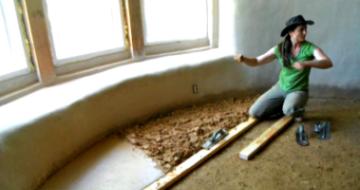
Are you a hands-on learner?
Looking for practical experience building actual natural homes?
Come join a Workshop

thick clay plaster covers the inside of insulating strawbale walls
strawbale walls can be curvy...especially if they are independent of the structure
strawbale walls create deep window sills
Strawbale infill construction does not rely on bales to carry any of the
building loads (other than the weight of the bales themselves). The bales infill
around any framing, meaning you can use any type of structural system that holds
up the floors and roof. Infill construction simplifies the building permit
process and can be less intimidating to builders and contractors,
because structural elements are conventional.
The basics of strawbale infill construction are simple to learn and
require no expensive tools. The skillset required to successfully install
strawbales includes: retying bales to a specified length, cutting notches to fit around
framing elements, and plastering.
The Process
1. Construct all structural elements (including foundation, walls, floors, roof)
2. Construct window & door framing plus interior walls (non-structural).
3. Dry-in roof and install finish roofing material.
4. Install strawbale walls.
5. Install doors & windows.
6. Rough-in and inspect electrical & plumbing.
7. Apply first coat plaster on interior & exterior.
8. Install all trim.
9. Apply second coat plaster on interior & exterior; shape walls tight to trim
10. Install any drywall; tape & float. Tape is also applied at connections
between plastered walls & drywall, including joint to ceiling.
11. Install any cabinets, countertops.
12. Apply finish plaster to interior & exterior, pigment as desired.
13. Install electrical & plumbing fixtures.
Schedule project-specific elements & inspections as appropriate.
•
Requires careful detailing to prevent liquid water infiltration
•
Requires breathable finishes, usually natural plasters, which may necessitate research or hiring a consultant
•
Necessitates educating yourself, the builder, and (often) building permit officials
•
Requires more interaction with permit officials in regions that do not currently have building codes for strawbale construction in place
•
Hired labor can be expensive, especially for plaster finishes
Challenges
strawbale infill wraps around a structural skeleton
SIZE
The size of strawbales depends on the
specific dimensions of the baling machine
that made them. There are 2 common
bale sizes in the USA:
18" wide X 14" tall
24" wide X 18" tall
INSULATION
Insulation is measured in R-value, which
quantifies how well a material resists heat
flow. The higher the R-value, the greater
the insulation.
Third-party testing of strawbales puts the
R-value between R-2 and R-2.7 per inch of
wall thickness. That means strawbales have
the following R-values:
18" bales = R-36 to R-48
24" bales = R-48 to R-64
For reference, model energy building code
requires that walls have R-19 insulation,
minimum.
Higher insulation means less heat flows
through the walls. Strawbale structures,
therefore, use substantially less
energy to heat and cool than
conventionally framed structures.
RELATIVE COSTS
Materials for strawbale wall systems
cost less than materials used in
conventional construction. (Material
costs make up about 1/2 of conventional
construction costs, compared to only 1/4 of a
natural home.) However, labor costs are
substantially higher for a natural building.
This accounts for many owner-built
strawbale structures costing a fraction of
what the same house would cost using
conventional materials.
As a general rule, however, the exact
same structure will cost the same
whether built conventionally or
naturally. (Assuming you pay for all labor
costs.) The difference is that a natural
building pays more for labor and
conventional construction pays more for
materials.
The biggest difference, of course, is that
costs for energy use over time will be lower
(and sometimes zero) for a natural home.
PESTS
Pest infestations are absolutely not an issue
with walls that are monolithic, have no
nesting cavities inside, and are finished with
thick plasters on both sides. The same is
true for bugs...as long as walls remain dry,
the inside of a strawbale wall does not have
enough food source or moisture to create a
suitable habitat for bugs.
truth window let's you show that yes, really, your walls are made from straw
strawbales in the process of wall building
electrical boxes attach to a wooden wedge
wiring mounts on the surface, since plaster is over 1.5" thick
FIRE RESISTANCE
Loose straw is highly flammable. Which
leads people to believe that strawbale walls
must also be flammable. However, quite the
opposite is true.
Fire needs 3 things: fuel, oxygen, and a
spark. The difference between loose straw
and a tight strawbale, is that there is not
enough oxygen inside a strawbale to
support a flame. In addition, strawbale
walls are finished with thick plasters...the
same materials used for fire-proofing.
Testing supports the fire-resistance.
Strawbale walls pass a two-hour
rating in a small-scale fire test (ASTM-
119), outperforming most standard types of
construction. Flame spread characteristics
and smoke development (ASTM E-84) also
exceed code requirements, with a flame
spread index of 10 and a smoke
development of 350.
MOISTURE
By far, the biggest concern with strawbale
walls...as with any construction materials...is
moisture. Any material that stays
persistently damp can support mold growth.
When biodegradable materials remain damp
they begin to decompose. This is true for
wood as well as straw.
Moisture infiltrates a wall in one of
two ways: as liquid water (such as from
a leaky pipe or roof) or as vapor/humidity.
Preventing liquid water migration requires
careful detailing (at wall penetrations and
horizontal surfaces). Humidity only becomes
a concern if it condenses inside the wall.
Which means eliminating cold spots inside
the wall (where humidity condenses into a
liquid) and using only vapor-permeable
finishes that allow humidity to migrate freely
through a wall.
Bales should be dry before
installation (15% or less moisture) and the
tops of all walls must be protected from rain
during construction.
INSTALLING ELECTRICAL
Installing wiring is actually more
simple with strawbale walls than with
conventional studs. This is because there is
no need to drill studs and snake the wires
through. Wires are simply surface
mounted to the bales using 4" landscape
staples or tucked between the bales. Plaster
is a minimum of 1-1/4" thick, which meets
the code requirement for wire location
behind the wall surface.
Junction boxes are attached to structural
elements or are screwed to wooden wedges
driven tightly into the monolithic bales.
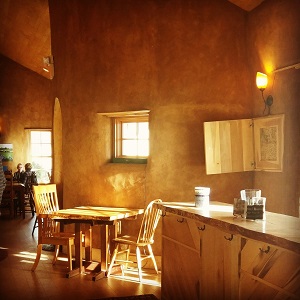
light bounces off clay plaster
Most habitable buildings in the USA require a building permit. And that's not a bad thing.
Building codes ensure that all structures perform at a baseline for safety,
durability, and energy efficiency.
Several states and counties throughout the USA have adopted building code amendments
for strawbale construction. However, you absolutely can get a permit for strawbale
buildings anywhere in the USA. Even if you do not live in a jurisdiction that specifically
spells out strawbale methods in their code. This is because strawbale wall systems
meet all of the performance requirements for wall systems everywhere in the
U.S.
Every building code begins with a paragraph that basically states something to this effect:
You may use alternative materials and methods that are not specifically laid out in this
code...IF...you demonstrate compliance with the INTENT of the applicable codes.
Demonstrating compliance means supplying testing data that explains safety & energy
performance. Luckily, testing data is available for free online, thanks to the
generosity of many strawbale pioneers in the 1990's.
1.
Educate yourself well on what and how you want to build. The permit officials will need to feel comfortable entrusting you with this non-standard construction method. If you do not feel confident with your knowledge, hire a professional that is acquainted with strawbale construction to assist you.
2.
Start an early dialog with your building officials. You can start with a phone call, but often face-to-face meeting is most effective. Be friendly and have a collaborative (not combative) attitude. If they are not already familiar with strawbale construction, provide them with printed information and additional resources. Do not overload them! If they ask you something you don't know, tell them so, and offer to provide additional information.
3.
Give them at least a week to review the information you provided. Then follow up and ask if they have any additional questions or concerns. Ideally ask them to itemize any concerns in writing.
4.
Address each concern in a clear, concise, and informed manner, and submit your response in writing. Again, get professional assistance if you are not confident with your knowledge.
small passive solar strawbale cottage with lime plaster
strawbales wrapped around timber framing
How to communicate with permit officials
The most important thing to keep in mind when getting a building permit is that the people
working in the permit office are there to collaborate with you.






.png)


